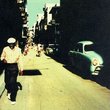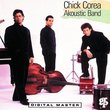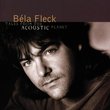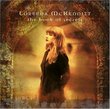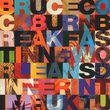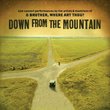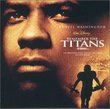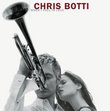| All Artists: Antonio Vivaldi, Fabio Biondi, Europa Galante Title: Vivaldi: Concerti per mandolini Members Wishing: 0 Total Copies: 0 Label: Virgin Veritas Release Date: 1/7/2003 Genre: Classical Styles: Chamber Music, Forms & Genres, Concertos, Historical Periods, Baroque (c.1600-1750), Classical (c.1770-1830), Instruments, Strings Number of Discs: 1 SwapaCD Credits: 1 UPC: 724354552724 |
Search - Antonio Vivaldi, Fabio Biondi, Europa Galante :: Vivaldi: Concerti per mandolini
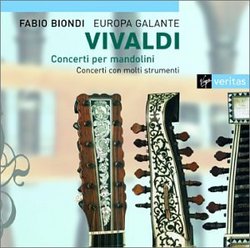 | Antonio Vivaldi, Fabio Biondi, Europa Galante Vivaldi: Concerti per mandolini Genre: Classical
The seven Concerti per Mandolini are diverse enough to disprove the frequently heard accusation that all Vivaldi concertos sound alike. Though they are cast in the same three-movement structure, each has its own character,... more » |
Larger Image |
CD DetailsSynopsis
Amazon.com The seven Concerti per Mandolini are diverse enough to disprove the frequently heard accusation that all Vivaldi concertos sound alike. Though they are cast in the same three-movement structure, each has its own character, from playful, ingratiating charm to ardor, high drama, and lamentatious intensity. The fast movements are stately and brilliant with scintillating running passages; the slow ones are songful, pleading, and melancholy. Though at times Vivaldi succumbs to his predilection for sequences, these pieces have an incredible variety of tonality, mood, and color, employing a large number of instruments in many arresting combinations; the final one requires 17 instruments. In addition to the solo mandolins, there are standard and unusual strings and winds, including such rarities as chalumeaux, theorbo, viole all'inglese, and violini in tromba marina. The performances, at lowered pitch, are splendid throughout: brilliant in the fast, virtuosic movements, perfect in intonation and balance, pure in sound, invariably expressive, often passionate. The players use vibrato sparingly and add elegant ornamentation and cadenzas. Biondi, director and concertmaster, has a wonderfully sweet tone and leads without dominating the group. One cavil: the musicians get louder on all ascending passages and softer on all descending ones, and they make a long pause before every final note. This approach may be stylistically "authentic," but it becomes an annoying mannerism through overuse and exaggeration. --Edith Eisler Similarly Requested CDs
|
CD ReviewsVivaldi and Europa Galante Make a Joyful Noise Dr. Christopher Coleman | 04/27/2004 (5 out of 5 stars) "As all reviewers on this page seem to agree, the first order of business is to jettison the old saw that Vivaldi wrote the same concerto 500 times. Certainly he can be faulted, as he always will, for falling back on too-obvious formulae (those oft-cited repeated sequences of his), but as for sounding alike: Just try the jovial, gallant first movement of RV 425 for solo mandolin and follow it with the somber, near-tragic opening of RV 319 for violin, oboes, and bassoon. Next, give RV 558 a spin; how different the grand, heroic sweep of this first movement! Now that we've disposed of the chestnut about the sameness of the concerti, we can talk about the performances of Biondi and Europa Galante. I find them enthrallingly virtuosic in the Bach-like noodlings required of the two violins and two cellos in RV 564, a truly captivating work reminiscent, for me, of the Third Brandenburg. On the other hand, Biondi captures perfectly the sober mood of RV 319, where sentiment overrules virtuosity.The two concertos for mandolins (RV 532 and RV 425) are some of Vivaldi's most genial, and they emerge with the right sense of dash and wit, while the two concerti RV 558 and RV 555 for "molti strumenti" make a grand noise, especially those raspy, rattling violini in tromba marina! On the other hand, the recorders, chalumeaux, theorbos, and cellos add a tenderness and grace in their solos that balance out the acerbity of these strange instruments. RV 555 increases the stereophonic effects with two harpsichords and with three violins against two viole all'inglese and the aforementioned cellos. In all, it's a remarkable sound world Vivaldi created in these two works, like nothing else in the concerto literature, and the virtuosi of Europa Galante make the music sound every bit as important as it should.The recording, made in a church, is both close-up and highly reverberant, which takes a little getting used to, but once the ear adjusts, it reveals the dividends paid by the close miking. The solos all emerge with crystal clarity and timbral purity, while the ensemble playing is detailed and analytical without being clinical, thanks to that reverb. Though the recording tends to highlight the high end of things, it is probably true to the big, bright sound picture Vivaldi "saw" when he conducted his all-girl orchestra at the Ospedale della Pieta. An exciting CD indeed." Study in Color Dr. Christopher Coleman | HONG KONG | 03/25/2006 (4 out of 5 stars) "Admittedly I bought this CD because it was the only recording of RV 558 that I could find in Hong kong. This is one of the most bizarre concerti grosso that has ever been composed; it is scored for 2 violini in trombe marina, 2 recorders, 2 mandolins, 2 chalemeaux, 2 theorbos and cello, in addition to strings and continuo (performed here on harpsichord). Clearly Vivaldi wanted to make a splash with this piece and he threw in everything in the back closet; the alternation of tone colors is really amazing. A word about these instruments, working backwards. The theorbo is an obsolete but astonishingly lovely member of the lute family; it's something like a cross between a harp (with 8 unfretted bass strings that can sound only a single note) and a twelve string guitar (with 6 pairs of fretted strings) but pitched low--the upper two strings are not considerably higher than the two strings below them, which makes for ease of fingering but limits the upper range. The chalemeaux are precursors of the clarinet and are aurally difficult to distinguish from their progeny. Mandolins are plucked/strummed stringed instruments with 4 pairs of strings tuned like a violin, and these instruments were most likely played by violinists. The violins in trombe marina are somewhat controversial; Europa Galante come down firmly on the side of the score that these are essentially regular violins fixed with an asymmetric bridge which causes a sort of buzzing or rattling sound rather similar to the buzziness of the harpsichord, oddly enough, and which was thought to imitate the sound of the obsolete and incredibly bizarre tromba marina. But other scholars have argued that the parts were meant for performance on actual trombe marina. The "Sea Trumpet" was in fact a stringed instrument thought to sound like a trumpet but be more agile (trumpets in those times did not have valves and so had a very limited pitch choice--they were essentially bugles.). It has only a single melodic string, rather long, but up to 50 strings that resonate with sympathetic vibration with the melodic string. To make things even more curious, only harmonics were played on the instrument, throwing the intonation of certain pitches completely out of the norm. The tromba marina gets its name in part because it was said to be heard best at a distance, as over a body of water. I can testify that this is true--it's really a hideous sound that you wouldn't want to hear close up, something like a viola being scratched against a chalkboard. It's hard for me to believe that Vivaldi really composed this piece not just for one tromba marina, but for two; beyond the horror of the noise lies the fact that the parts probably aren't even close to possible on the tromba marina, but lie perfectly well on the violin. At any rate, the piece is about color in a way that probably no one other than Bach conceived of for a very long time. And herein lies my complaint (a minor one); the performance is lovely, but I sometimes find the harpsichord overwhelming. It's especially difficult to hear the theorbos--they're so low; and to distinguish the violins in trombe marina sometimes--they match the harpsichord sound too much. Granted, in the Concerto RV 555, the two harpsichords are solo instruments and should be treated as such. But how RV 558 would flourish with less harpsichord--it would be such a treat. At any rate, these are all delightful pieces, really some of Vivaldi at his best if you're tired of the Four Seasons, and certainly worthwhile performances." Who says baroque stuff can't be electrifying? Louis Lee | Princeton, NJ United States | 01/13/2004 (5 out of 5 stars) "This is one of the most encouraging and exciting discs in 2002! After a few hours of Vivaldi listening, one often gets the impression that he spinned out new concerti by applying the same formula - they all sound vaguely the same, after all. Vivaldi fatigue I call it. That's all the more why we need a disc like this: Biondi and his superb Europa Galante show that Vivaldi concerti can be full of surprises and excitement, and extremely colourful writings. These are readings of high drama and strong emotions, it's hard to imagine anybody not moved by the sheer energy level and dedication. Concerto RV 576 gets a superb airing especially."
|

 Track Listings (21) - Disc #1
Track Listings (21) - Disc #1